Many gamers quite understandably have a lot of nostalgia for the late 1990s and early 2000s of PC gaming. This was a time when many of the most well regarded games were released across multiple genres. At the same time software was becoming more streamlined which solved a lot of compatibility issues and 3D hardware acceleration was becoming standard. And the early results were much better than what was being produced on consoles. Just off the top of my head consider that Diablo, Half-Life, Fallout, Baldur’s Gate, Thief, Quake, StarCraft, Unreal and Deus Ex were all released in this period. That is if you begin from late 1996 and end late 2001. That’s impressive for a five year period given that all of these remain recognised titles today and this is far from an exhaustive list. If I tried to do the same for the last decade while excluding games from existing franchises, I would not only have to give it far more thought, I’d be struggling to find comparably memorable games at all.
One of the biggest names in the industry at the time was John Romero who along with John Carmack had a significant impact on PC gaming for most of the 1990s with games like Commander Keen, Wolfenstein 3D and most notably with Doom. I played all three of these games and later Quake but I had no idea at the time who was making these games. I didn’t even know they were made by the same group of developers. This was just as true for who was making the games I played on Nintendo and Sega consoles. Most of this would be learned later through various online articles on fan websites and later still after reading books like Game Over by David Sheff and Masters of Doom by David Kushner. When I was young, I simply didn’t care who made them — just that they were fun.
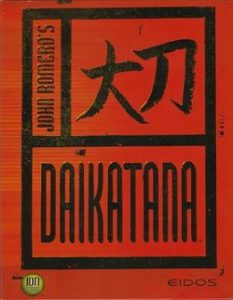
Daikatana was a game I found out about after the fact because I don’t recall any fanfare behind it at the time though I certainly played PC games. It was through websites like Something Awful that I got a sense of the notoriously negative reputation the game has and has continued to have since. I do remember trying the demo after learning about it and I even had the same issue installing it as shown in the linked article. After that short experience, I assumed it was just as bad as was generally claimed. In hindsight, SA had a very negative influence on my late adolescence and early adult life and I find that article (and the website in general) barely readable today. However, at the time it was very influential and a lot of what is considered part of “Internet culture” originated there.
There I would have left Daikatana if not for the release of the unofficial 1.3 patch in 2019 which fixes a great deal of issues noted at the time along with some other enhancements. This made me curious enough to finally give this game a shot.
First up, this is not a contrarian article that will claim all the critics were wrong at the time and that this game is actually great or even a masterpiece. Even with the patch, Daikatana still has a lot of issues and compares unfavourably with most of the big releases of the period and it most certainly hasn’t aged like wine. The only defence against the critics of the time I will offer is that its mediocrity is exaggerated due to the high expectations it had. This is similar with a film like Waterworld which was a financial disaster and is unfairly considered an even worse film because of that. It isn’t a terrible film though. Daikatana isn’t a terrible game either.
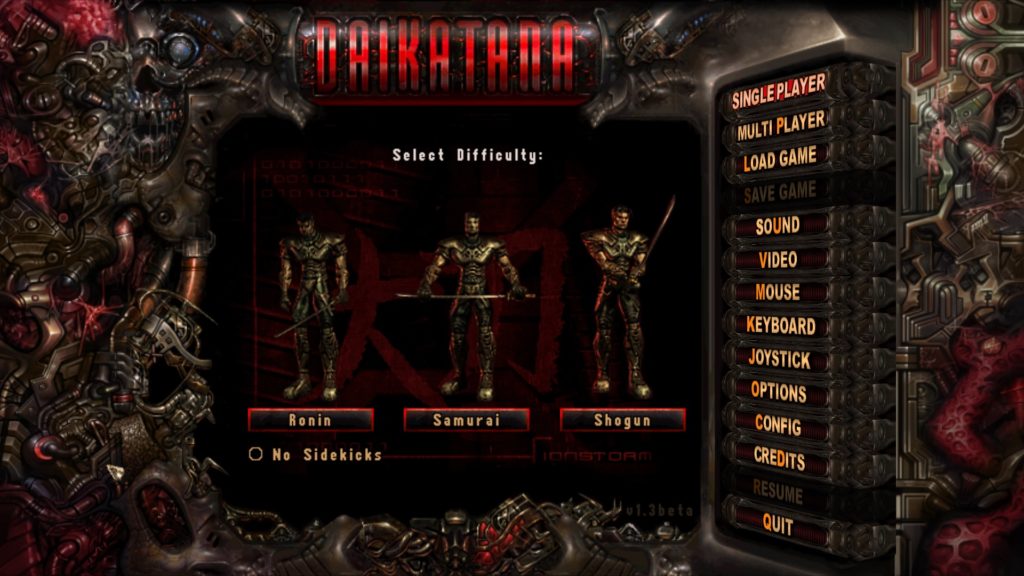
I also don’t want to defend Romero like many now seem to do; he began advertising a product before it existed and simply didn’t deliver. I don’t have a problem with the aggressive advertising as it wasn’t uncommon at the time and the over-the-top promotion with Stevie Case would have been all but forgotten had the game been generally up to expectations. Before writing this I found a somewhat recent interview with Case who was in a relationship with Romero and was used for promoting the game as well as being a level designer. In the linked interview she barely mentions Romero and Daikatana isn’t even named. As she was very young at the time, I do think she was treated poorly and can understand her bitter feelings on the subject. As of writing, Romero is apparently working on a new FPS but he seldom brings up Daikatana and it isn’t listed with Doom and Quake in his Twitter bio. I am not sure about the other developers but I hope they went on to do great things.
For a quick rundown of the game, Daikatana is has a cyberpunk setting with the player taking the role of Hiro Miyamoto, a Japanese martial artist whose ancestor forged a sword known as the “Daikatana”. After checking the compound in Japanese (大刀), the name would be “daitou” or “longsword” which takes away from an otherwise flashy title. I have also seen some saying that pronouncing it “daikatana” in Japanese would be like saying “sword big” in English. Anyhow, this sword has caused conflict throughout history and Hiro Protagonist Miyamoto is caught up in an adventure that will span across four different time periods. It was very ambitious in scope — especially seeing as Romero’s early games with id Software had been light on narrative and the settings while different, often blended together.
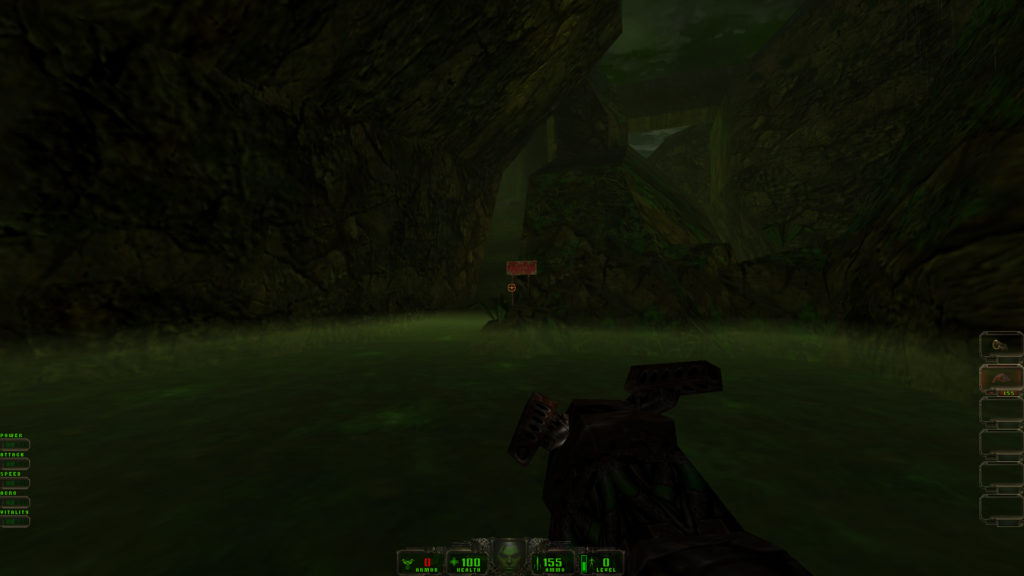
The game opens impressively with a lengthy in-game cinematic setting up the story and there are a number of these throughout the game. The writing and voicework was bad but it generally was in most games at the time — including many that are more fondly remembered. The opening level of the game is the same as the demo and it is one of the worst opening levels in a game that I can recall. This is where all the complaints about fighting bugs came from because most of this level is indeed running about a swamp shooting bugs and frogs. While this isn’t representative of the game as a whole, it gives a poor first impression. Though the bugs disappear early, the game does have many small irritating enemies throughout; many of which also cause a poison status effect. What baffles me is why they decided to make this opening level the basis for the demo as that there are plenty of levels that would have put the game in a more positive light to would-be buyers. It would have even been a better game if the opening level was cut out altogether.
There are actually four episodes with about six levels for each. Each of these is set in a different time and interestingly the available weapons change significantly each episode because of this. The opening is set in 2455 AD Japan which makes the opening swamp all the more absurd as a beginning but it soon gives way to the futuristic Mishima Corporation fortress. The available weapons quickly expands and you’re soon taking on robotic enemies as well as more conventional guards… and some more bugs. I found myself sticking to the Ion Blaster picked up at the game’s beginning as many of the others have large areas of effect that your character can easily get caught in. This trend would continue for most of the game as I found the Discus weapon the most effective in 1200 BC Ancient Greece and the Sliverclaw melee weapon in 560 AD Norway. The final episode in 2030 AD San Francisco had a more conventional weapon selection so I found myself switching between them far more often.
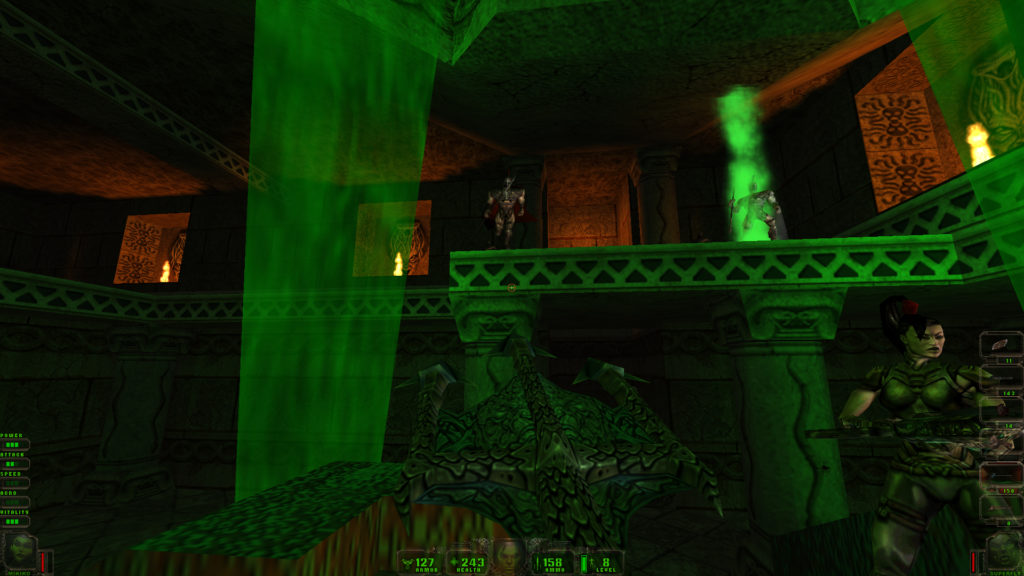
By about the third level of the first episode, I was find the game a lot more fun with some genuinely thoughtful level design. There was inconsistency with the difficulty at times as there were sections with seemingly relentless waves of enemies but it provided a good level of challenge. This did mean re-doing a few sections and this is where the annoying save system became a problem. Most games on PC had allowed players to save anywhere but Daikatana limited players to map changes and by collecting “Save Gems” found on each level. These are mostly well-placed but I generally consider them an unfair and unnecessary limitation on the player.
Daikatana also included a rudimentary progression system and points are increased exclusively through combat encounters. These cover the usual with increasing weapon power and player vitality being more important early on. These increases do make a big difference too. I didn’t put much into speed or acrobatics but they are still potentially useful. By the time of the games release System Shock 2 had already been released and Deus Ex would release later that year. It was still unique at the time to have this included in an FPS and it was well-implemented.
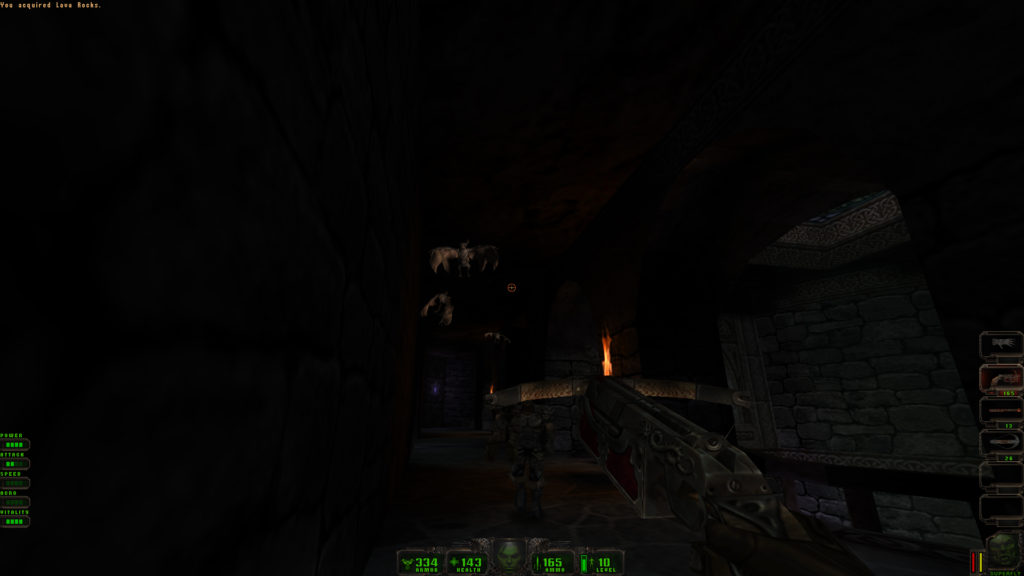
The middle part of the first episode also introduces the sidekick characters, namely Superfly Johnson and Mikiko Ebihara. Both of these characters accompany Hiro for large portions of the game though rarely together. Mikiko is only rescued at the end of the first episode and both characters disappear and reappear in different episodes at various points I will not detail. These two characters attracted the most criticism from people who actually played the game. First-person shooters were almost invariably one-man shows outside of multiplayer arenas and Daikatana was one of the early attempts to introduce characters that help the player. These two however spend more time getting stuck in geometry or in the player’s path than anything else and fixing their path-finding was a major area that the 1.3 patch addressed. Unfortunately, these issues remained on my playthrough though I am certain they were much less of a problem than for players experiencing the original game. They can be given some simple orders but I mostly used this when I wanted them to avoid getting stuck. The 1.3 patch also increased their health significantly and even had the option to removed them altogether; though I left them in as recommended. Right up to the very last area of the game these two were causing me problems and their canned wisecracks got old very fast. Even without hindsight, I can’t understand why they were given such a prominent place in the game given they were mostly detrimental to the experience even with the improvements I could take advantage of. Still to this day developers are loathe to have non-player characters too involved in gameplay as “escort missions” are notoriously unpopular and this was an early warning.
I probably enjoyed the second episode in Ancient Greece the most as it was the most unique part of the game and had some of the better level design most notably with the later level inside the Acropolis. Fighting various mythical creatures as well as Greek Hoplites with razor discus a trident and even a giant scorpions tail was consistently fun and even today it remains an original setting for an FPS. This episode also gives Hiro use of the titular “Daikatana” which can be powered up through use in combat. I didn’t find it especially fun to use but it can become a formidable weapon .

Ancient Greece ends with a battle with Medusa which turned out to be very anticlimactic as did all the following bosses in the game. These encounters are few and far between but there are some regular enemies that offer more challenge. In the third episode there was a fight with a sorcerer who got stuck on some stairs and allowed me to quickly dispatch him from the entrance. Right before this encounter I had been warned that he would be a challenging foe by Superfly which made the encounter even sillier. Even the final boss goes down mere seconds into the battle.
I have saved what I consider to be Daikatana‘s greatest strength until last and that is the music. I had no idea what to expect with this and this might explain why I was so impressed. I’ve listened to it outside the game a number of times and it really is excellent. The soundtrack varies with each episode and suits the various settings perfectly. The opening cyberpunk setting is suitably electronic, with more ambient tracks in Ancient Greece and Norway. The final episode in the near future is a metal score similar to Doom and Quake II. There are also nice little touches such as remixes of Doom tracks including an elevator-style version of the game’s opening track in the Mishima HQ lobby. They had had number of artists work on the soundtrack (I assume on different episodes), and the overall result is very impressive.
Daikatana does have a few high-points and despite the end result, one can admire the ambition. I think with a narrower focus and better management it could have met expectations. As the game is, I doubt I would have seen it through without the unofficial patch and even with it, there is a lot more frustration than fun at many points in the game.
So would I recommend it? Only if you’re as curious as I was but don’t expect an underappreciated gem. It has a genuinely excellent soundtrack and it is one of the early attempts of games to have more narrative focus. It also attempts to move away from key-hunting monster mazes that characterised many early FPS games. Unfortunately a number of notable games before and many after did the latter two much more competently. With all that said, it does speak well of the game that there were people devoted enough to work on improving the game after so many years.
On a final note, I described particularly 1990s PC development as “cowboy days” in a post from last year and I think Daikatana marks the time when this ended. I don’t mean to say that it was directly responsible but that this was the period when many developers came under more corporate (and therefore risk-averse) management. This had obviously already happened for much of console gaming and existed with Japanese developers from the beginning but I think it is apt to look at these years of PC gaming as a kind of an untamed frontier of creativity — just look at the results! Obviously many great games followed but there is a noticeable change after this period. Ultimately the best thing to come from Romero’s Ion Storm was Deus Ex but this was actually created by a separate studio under Warren Spector.
